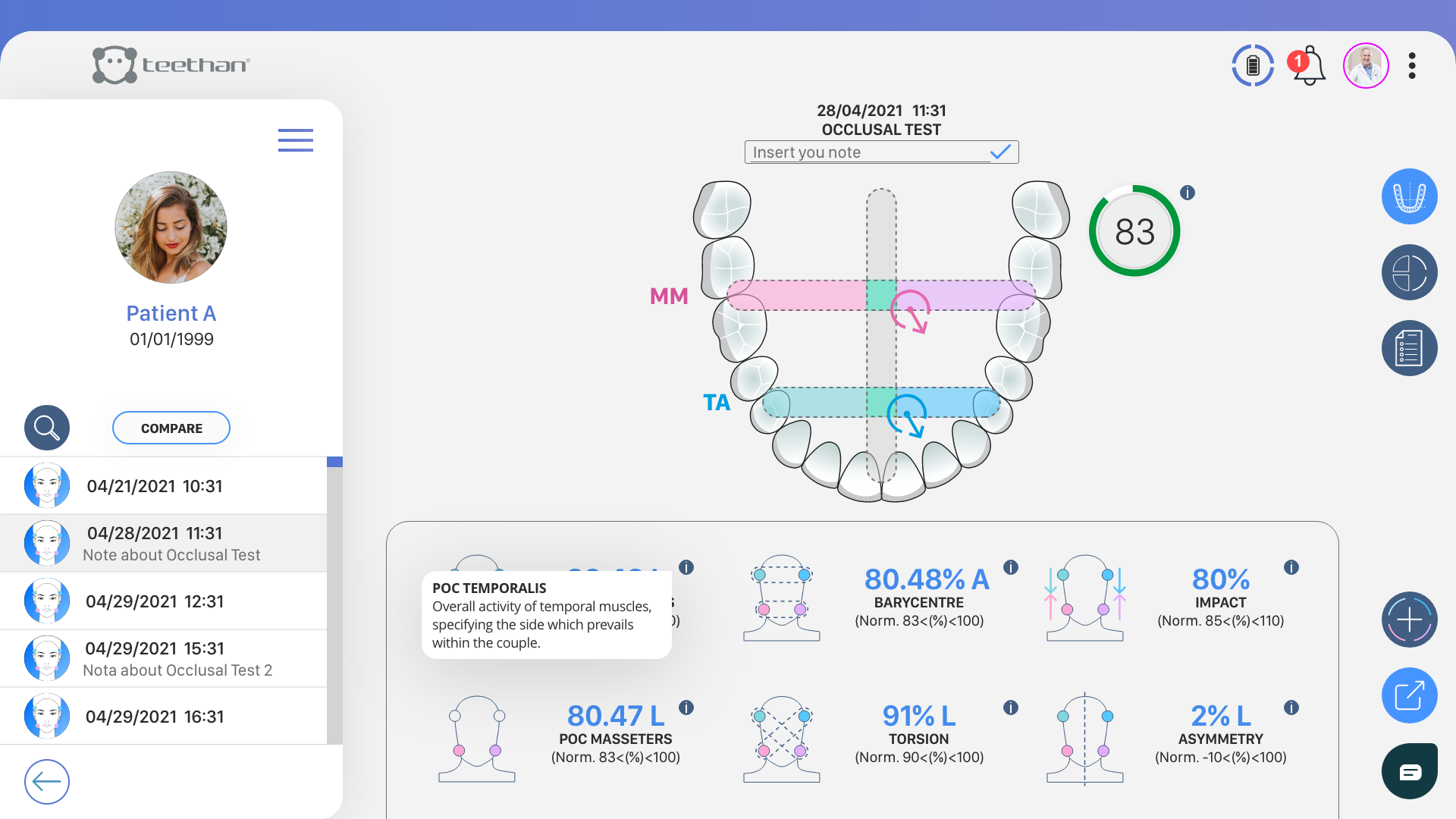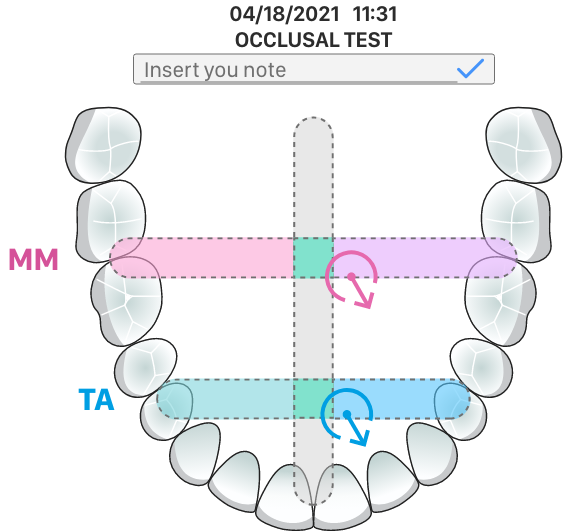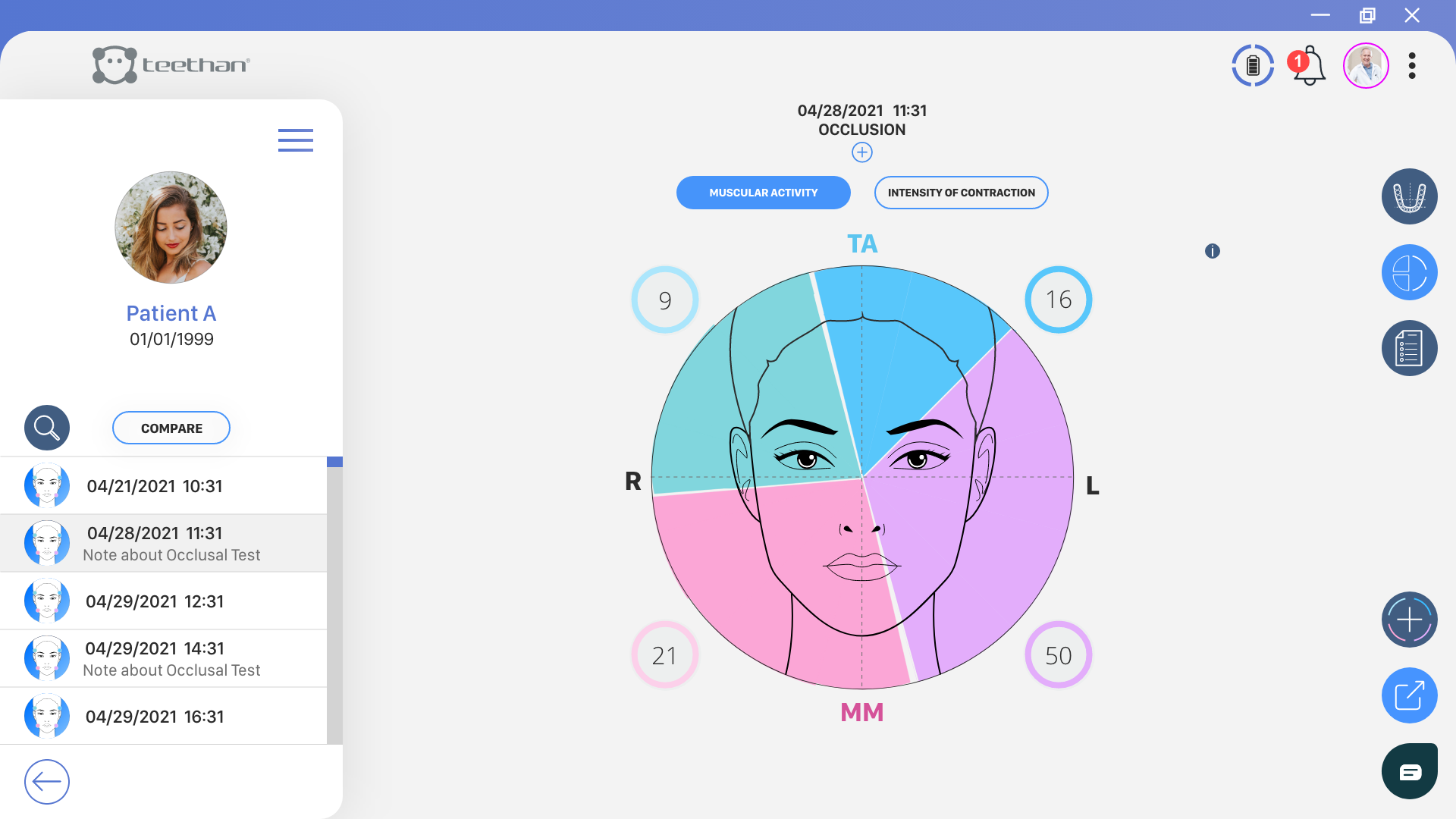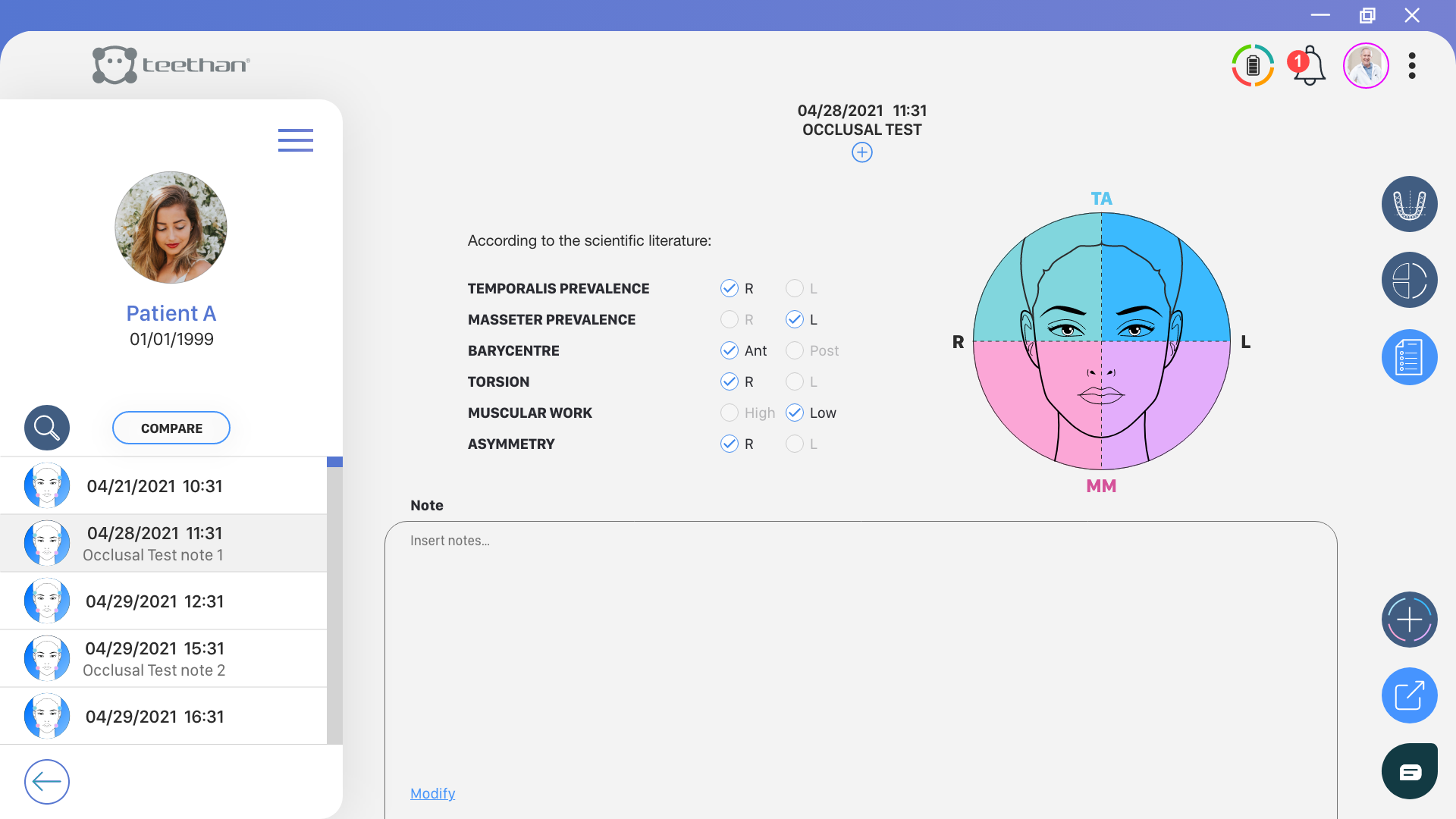At the end of the acquisition process, the report is automatically generated. Read here to learn about your Teethan Occlusal Test indices.
Occlusal Plane Parameters and Indices

The representation of the dental arch includes two targets. The ![]() target refers to
target refers to  the activity of the Temporalis muscles (that affect the front of the mouth). The
the activity of the Temporalis muscles (that affect the front of the mouth). The ![]() target refers to the activity of the Masseters muscles (that affect the back of the mouth).
target refers to the activity of the Masseters muscles (that affect the back of the mouth).
The dashed bars represent WNL values of indexes. The intersections ![]() are areas where both targets appear in case of perfectly balanced occlusion.
are areas where both targets appear in case of perfectly balanced occlusion.
Immediately beside the image of the dental arch, the Global Index of Neuromuscular Balance is displayed. It is represented with a color-coded biofeedback ring:
![]() Green, when the global balance is greater than 83%.
Green, when the global balance is greater than 83%.
![]() Yellow, when the global balance is between 82% and 75%.
Yellow, when the global balance is between 82% and 75%.
![]() Red, when the global balance is less than 74%.
Red, when the global balance is less than 74%.
Percentage Overlapping Coefficient (POC)
Overall activity of the Temporalis/Masseters muscles, specifying the side which prevails within the couple.
POC index states, as a %, the difference in neuromuscular activity of a Temporalis/Masseter pair in maximum voluntary contraction (MVC), when compared to the analogous standardized value.
If the two muscles of the same pair contract symmetrically, the expected theoretical result of POC is close to 100.
WNL is 83% and higher.
The vertical dashed central line, with a light grey color, indicates the normal range, up to 83% value. To the left and the right of the central line, to represent the predominance of the right or left muscle activity.
Barycentre (BAR)
Comparison between Temporalis and Masseters muscles activity.
This index is obtained by calculating the Percentage of Overlapping Coefficient between the two Temporalis and the two Masseters – revealing a neuromuscular center of occlusal balance. This index will show a bite that has an anterior predominance, or a posterior predominance.
When the contact points tend to concentrate on molars, Masseters record a greater contraction than the corresponding Temporalis muscles (posterior barycentre). Conversely, in the occlusal condition where the barycentre moves to the antero-lateral sectors (i.e. up to the first-second premolar), the temporal muscles state greater contractile forces (anterior barycentre). In this case, there is an overload of bilateral joints that, over time, can lead to pathological conditions.
WNL is 90% and higher.
Torsion (TORS)
Evaluation of cross-activity of the two pairs of muscles, to reveal a possible torsion attitude of the mandible.
It is the result of the comparison of the force couple of crossed muscle pairs: right Temporalis and left Masseter; left Temporalis and right Masseter.
The result of the action of the Temporalis muscle added to the strength of the contralateral Masseter muscle, generates a pair of forces with a torsional moment that tends to latero-deviate the mandible towards the side of the Temporalis of the couple.
WNL is 90% and higher.
When TORS is not WNL, muscles tend to create a lateral displacement of the jaw to the right (R) or to the left (L), depending on whether one of the other muscle pair prevails.
Targets that present an arrow indicate the presence of torsion ![]() .
.
Asymmetry (ASIM)
Comparison of the activity of the right and left side muscles to identify dominant side and any possible asymmetries.
A positive value indicate a greater activation of the right-hand side, while a negative value indicates a greater activation of the left-hand side.
WNL is between -10% (L) and 10% (R).
Impact (IMP)
Evaluation of intensity of muscle work of the analyzed muscles to provide a quantification of the bite strenght.
WNL is between 100% and 115%.
Values above the standard suggest the formulation of a diagnosis proprioceptive inhibition and thus pain in MVC or reaching chronic levels due to the presence of a protective nociceptive reflex. Sub-standard values can state a condition of acute proprioceptive inhibition and thus pain in MVC or reaching chronic levels due to the presence of a protective nociceptive reflex.
If POC, TORS and BAR indexes are WNL, the IMP index is related to the vertical dimension. The user is provided with indications of the possibility of raising (index higher than normal limits) or decreasing (index lower than normal) the vertical dimension compatibly with the aesthetic condition of the patient.
Muscular Activity & Intensity of Muscular Contraction
In this page, it is possible to visualize the distribution of the average and normalized muscular activity by clicking on ![]() , or the intensity of contraction of each investigated muscle by clicking on
, or the intensity of contraction of each investigated muscle by clicking on ![]() .
.
In the first case,

each sector of the pie chart is colored proportionally to the muscle's activation. A good neuromuscular balance, corresponding to the absence of malocclusion, each slice will be similar in area to the others, each portion equal to 25%.
In the second case,
-png.png)
the muscle that expresses the greatest amplitude value is represented with a full bar, while the other are represented proportionally to it.
Normality Values and Notes

In this page, it is possible to visualize the self-reading of the not WNL data and add clinical notes for the personalization of the report. In the upper area, the not WNL values are highlighted. This section is filled in automatically and it's not possible to make any changes.
The lower area is dedicated to notes and information related to the Occlusal Test performed by clicking on the Modify button and save with the Save button.
